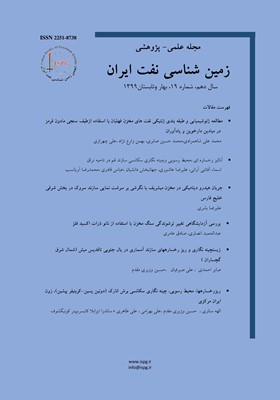بررسي آزمايشگاهي تغيير ترشوندگي سنگ مخزن براي جلوگيري از تشكيل رسوب آسفالتين با استفاده از نانو ذرات اكسيد فلز
محورهای موضوعی : زمین شناسی مخازن نفتعبدالحمید انصاری 1 , صادق عامری 2
1 - دانشگاه آزاد اسلامی ،واحد لامرد
2 - دانشگاه آزاد ،واحد لامرد
کلید واژه: امولسیون, رسوب آسفالتین, نانو ذرات, جذب سطحی, تغییر ترشوندگی,
چکیده مقاله :
یکی از روشهای ازدیاد برداشت از مخازن نفتی تزریق نانوسیالات میباشد. نانو ذرات از طریق تغییر ترشوندگی، کاهش کشش سطحی، کاهش گرانروی نفت باعث افزایش برداشت نفت از مخازن میشوند. نانوذرات اکسید فلز (نانو ذرات سرامیکی) بیشترین کاربرد را در افزایش برداشت از مخازن دارند. در این پژوهش به بررسی تغییرات در سطوح تماس نفت/آب/سنگ در حضور و عدم حضور نانوذرات اکسید فلز پرداخته شده است. تغییر ترشوندگی سنگ در غلظتهای مختلف نانوذرات در فاز آبی آنالیز شده و مکانیزم حاکم برای تغییر ترشوندگی سطح سنگ در دو کاتگوری نانوذرات اکسید فلز ارایه شده است. 4 نانو ذره مورد استفاده در این مطالعه عبارتند از: TiO2, NiO, Co3O4, Al2O3 سپس از نمونهها بوسیله دستگاه DSA عکسبرداری و زاویهها اندازهگیری شد و مشاهده گردید که بیشترین شیب گراف مربوط به اکسید نیکل و پس از آن اکسید کبالت و سپس اکسید تیتانیوم و کمترین شیب به اکسید آلومینیوم مربوط میشود. در این میان از این نقطه نظر، بترتیب نانو ذره ها بصورتNiO > Co3O4 > TiO2 > Al2O3 قابل بررسی در انتخاب میباشند. بنابراین پیشنهاد اول برای انتخاب مناسبترین نانو ذره اکسید فلز، NiO و برای مقام دوم انتخاب Co3O4، انتخاب سوم و چهارم بترتیب TiO و Al2O3 میباشد.
One of the methods of harvesting oil reservoirs is the injection of nanoparticles. Nanoparticles increase oil recovery from reservoirs by changing wettability, reducing surface tension, reducing oil viscosity. Metallic nanoparticles (ceramic nanoparticles) have the highest application in increasing the absorption of reservoirs. In this research, changes in the contact levels of oil, water, and stone in the presence and absence of metal oxide nanoparticles have been investigated. The change in the rock's wettability has been analyzed in various concentrations of nanoparticles in the aqueous phase and the governing mechanism for changing the rock solidity in two metal oxide nanoparticles is presented. 4 nanoparticles used in this study are TiO2, NiO, Co3O4, Al2O3 The specimens were then measured by the DSA and the angles were measured and it was observed that the maximum gradient of the graph is related to nickel oxide followed by cobalt oxide and then titanium oxide and the lowest slope to aluminum oxide. In this respect, from this point of view, Nano particles are considered as NiO> Co3O4> TiO2> Al2O3, respectively. So the first suggestion is to select the most suitable nanoparticles of metal oxide, NiO, and for the second position Co3O4, the third and fourth choices are TiO and Al2O3, respectively.
[1] Shi, C., Zhang, L., Xie, L., Lu, X., Liu, Q., Mantilla, C. A., ... & Zeng, H. (2016). Interaction Mechanism of Oil-in-Water Emulsions with Asphaltenes Determined using Droplet Probe AFM. Langmuir, 32(10), 2302-2310.
[2] Strassner, J. E. (1968). Effect of pH on interfacial films and stability of crude oil-water emulsions. Journal of Petroleum Technology, 20(03), 303-312.
[3] Nassar, N. N., Hassan, A., & Pereira-Almao, P. (2011). Metal oxide nanoparticles for asphaltene adsorption and oxidation. Energy & Fuels, 25(3), 1017-1023.
[4] Kazemzadeh, Y., Eshraghi, S. E., Sourani, S., & Reyhani, M. (2015). An interface-analyzing technique to evaluate the heavy oil swelling in presence of nickel oxide nanoparticles. Journal of Molecular Liquids, 211, 553-559.
[5] Nassar, N. N. (2010). Asphaltene adsorption onto alumina nanoparticles: kinetics and thermodynamic studies. Energy & Fuels, 24(8), 4116-4122.
[6] Ogolo, N. A., Olafuyi, O. A., & Onyekonwu, M. O. (2012, January). Enhanced oil recovery using nanoparticles. In SPE Saudi Arabia Section Technical Symposium and Exhibition. Society of Petroleum Engineers.
[7] Ogolo, N. C., Olafuyi, O. A., & Onyekonwu, M. (2012, January). Effect of nanoparticles on migrating fines in formations. In SPE International Oilfield Nanotechnology Conference and Exhibition. Society of Petroleum Engineers.
[8] Souza, V. B., & Mansur, C. R. (2015). Oil/Water nanoemulsions: Activity at the water–oil interface and evaluation on asphaltene aggregates. Energy & Fuels, 29(12), 7855-7865.
[9] Yang, F., Tchoukov, P., Dettman, H., Teklebrhan, R. B., Liu, L., Dabros, T., ... & Xu, Z. (2015). Asphaltene Subfractions Responsible for Stabilizing Water in Crude Oil Emulsions. Part 2: Molecular Representations and Molecular Dynamics Simulations. Energy & Fuels, 29(8), 4783-4794.
[10] Franco, C. A., Nassar, N. N., & Cortés, F. B. (2014). Removal of oil from oil-in-saltwater emulsions by adsorption onto nano-alumina functionalized with petroleum vacuum residue. Journal of colloid and interface science, 433, 58-67.
[11] Hamedi Shokrlu, Y. , Babadagli, T., “In-Situ Upgrading of Heavy Oil/Bitumen During Steam Injection by Use of Metal Nanoparticles: A Study on In-Situ Catalysis and Catalyst Transportation”, SPE 146661-PA, 2013.
[12] Ogolo, N.A. , Olafuyi, O.A. , Onyekonwu, M.O. , “Enhanced Oil Recovery Using Nanoparticles” , SPE 160847-MS, 2012.
[13] Haroun,M., AlHassan,S., Ansari, A., Al Kindy,N., Abou Sayed,N., Ali,B., Sarma,H., “Smart Nano-EOR Process for Abu Dhabi Carbonate Reservoirs” , SPE 162386-MS, 2012.
[14] Nanopowders and Nanoparticles from US Research Nanomaterials, Inc. US Research Nanomaterials, Inc. Available from: http://www.us-nano.com [Accessed 1 February 2018].
[15] "Organic Polymer Chemistry."— Presentation transcript . . Available from: www.google search .com , Published by Erik Greer.
[16] Galoppini, G., M. Tambini, “Asphaltene Deposition Monitoring and Removal Treatments: An Experience Deep Wells”, SPE 27622, 1994.


